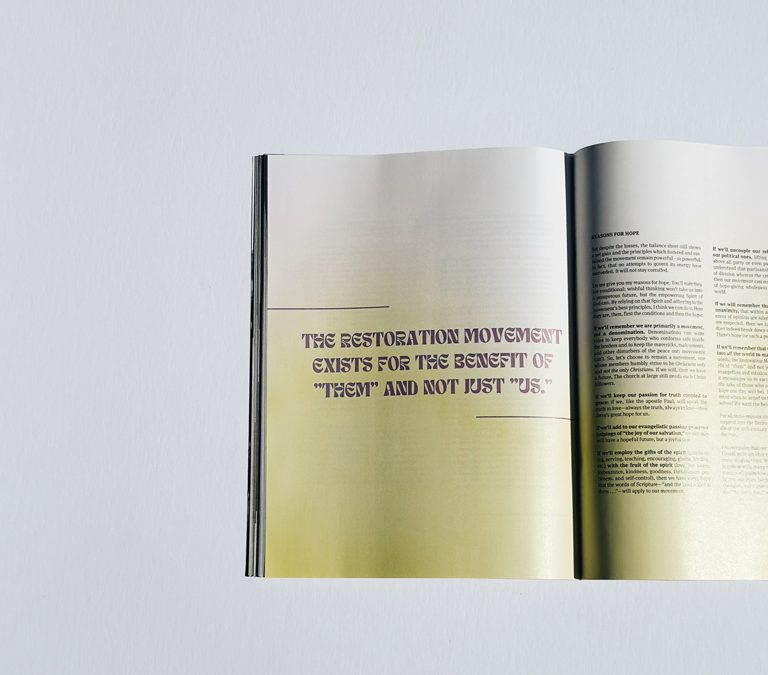By Jerry Harris
Earlier this year, it seemed the whole country was caught up in the cancellation of Bud Light, America’s best-selling beer. The turmoil resulted from a promotion that connected the brand to Dylan Mulvaney, a transgender TikTok influencer; Bud Light sent personalized beer cans to Mulvaney celebrating both March Madness and Mulvaney’s yearlong transition to identify as a woman. Mulvaney’s videos on social media triggered a backlash that caused many Bud Light beer drinkers to reject the iconic brand.
In just a few weeks, Anheuser-Busch lost $5 billion in market value, 17 percent in sales, and 21 percent in market volume. Two executives responsible for the campaign were put on administrative leave, and the brand enlisted the help of Anheuser-Busch global marketing executive Todd Allen to get them back on track.
But what does any of that have to do with the Restoration Movement?
THE DIFFERENCE BETWEEN SHAREHOLDERS AND STAKEHOLDERS
A few weeks into the controversy, Anson Frericks, a former Anheuser-Busch executive, was interviewed by Will Cain, who asked whether conservative consumers are likely to put this controversy in the rear-view mirror.
Frericks said, “That’s the bet [Anheuser-Bush is] making. I think that’s the wrong bet to make.”
Frericks’s primary argument hinged on what he described as the difference between “shareholders” and “stakeholders.”
Shareholders, Frericks said, are those who drank the beer, purchased the brand, invested in the stock as part of their retirement portfolios, and made it a part of their lives.
Stakeholders, on the other hand, he described as organizations who leveraged a brand’s capital by working with political and activist organizations to try to reach a wider target. Such efforts, in this instance, ventured afield from what the shareholders are about—humor, sports, and the things that bring us together rather than those that tear us apart . . . such as social and political hot-button issues.
Frericks’s analogy of shareholders and stakeholders is where I saw the connection with the Restoration Movement.
Kent Fillinger shared data with me from the U.S. Religion Census. The data showed there are 4,787 Christian Church/Church of Christ congregations with 1,379,041 adherents. (As Kent mentions in his Metrics column this month, a Wall Street Journal article indicates the actual numbers might be 26 to 40 percent higher.) But the state-by-state breakdown of where these congregations are located is what I found most interesting. You see, nearly 600,000 (42 percent) of Independent Christian Church adherents are located in four states: Indiana, Illinois, Kentucky, and Ohio.
RESTORATION MOVEMENT SHAREHOLDERS AND STAKEHOLDERS
The people who attend, serve in, and tithe to our churches are our shareholders. Beyond that, we have plenty of parachurch organizations like conferences, Bible colleges, mission organizations, church extension funds, and publications like Christian Standard that tend to be more like stakeholders. These parachurch entities seek to influence the churches they serve by highlighting and promoting their area of focus, be it education, growth, innovation, Bible translation, worldwide missions, financial investment, discipleship, news, networking, unity, or something else.
The particular passions of these stakeholders are great, and their desires are noble, but the movement is really about present shareholders and possible future shareholders. Ultimately, the Restoration Movement is about the people—the shareholders—of those individual churches.
The old saying goes, “All politics is local,” but it is especially true in our movement in terms of the incredible value of each church’s independence. “All church is local” fits us . . . and our churches find their epicenter in the Midwest, particularly among the four states we have listed.
That’s not to say that the people and churches in the other 46 states are less important to the whole, but it does serve as a reminder of where almost half of our shareholders live and worship. And while some of the largest individual churches might be located in those 46 “non-core” states, the largest concentration of our shareholders are not. For example, the largest American Independent Christian Church is in Arizona, but Arizona has only 19 percent as many ICC adherents as Indiana.
As parachurch organizations or stakeholders, we need to understand that shareholders (church members) are in relationship with their local churches to a much greater degree, in most every case, than with us. If we (parachurch organizations and stakeholders) are trying to influence on a national level in conferences, we need to shape our passions around what those shareholders stand for, believe in, invest in, and build their lives around.
I’ve noticed that our conferences can become focused on a particular topic or agenda that serves more to divide than to connect. We should pause for a few moments and consider how much we agree on regarding our distinctives. Then, I think, we would be more inclined to leave important but nonessential issues to local church leaderships and their shareholders.
Our located colleges and universities are places where biblical and behavioral authority is leveraged with students, so those institutions should be clear and forthcoming about their theological positions, approach to Scripture, and disciplinary processes before students sign up for classes and before churches support the institutions. Many churches have a “playbook” about how they determine important but not essential issues. It would be helpful for unity if places of higher education did the same.
Publications like Christian Standard need to be environments of honest and respectful debate over important but nonessential issues where our unity is leveraged for greatest effectiveness. Parachurch ministries like our extension funds, mission organizations, and other services exist to serve the needs of the church. Still, these ministries can face difficulties because of competitiveness among themselves. While such competition is unavoidable among nonprofits, we must admit it and still compete in God-honoring ways.
The stakeholder/shareholder analogy is a good one, I think, when we see how our fellowship of churches and ministries operate and how we might do our best to foster unity as we hold firmly to our clear distinctive of church autonomy.






0 Comments